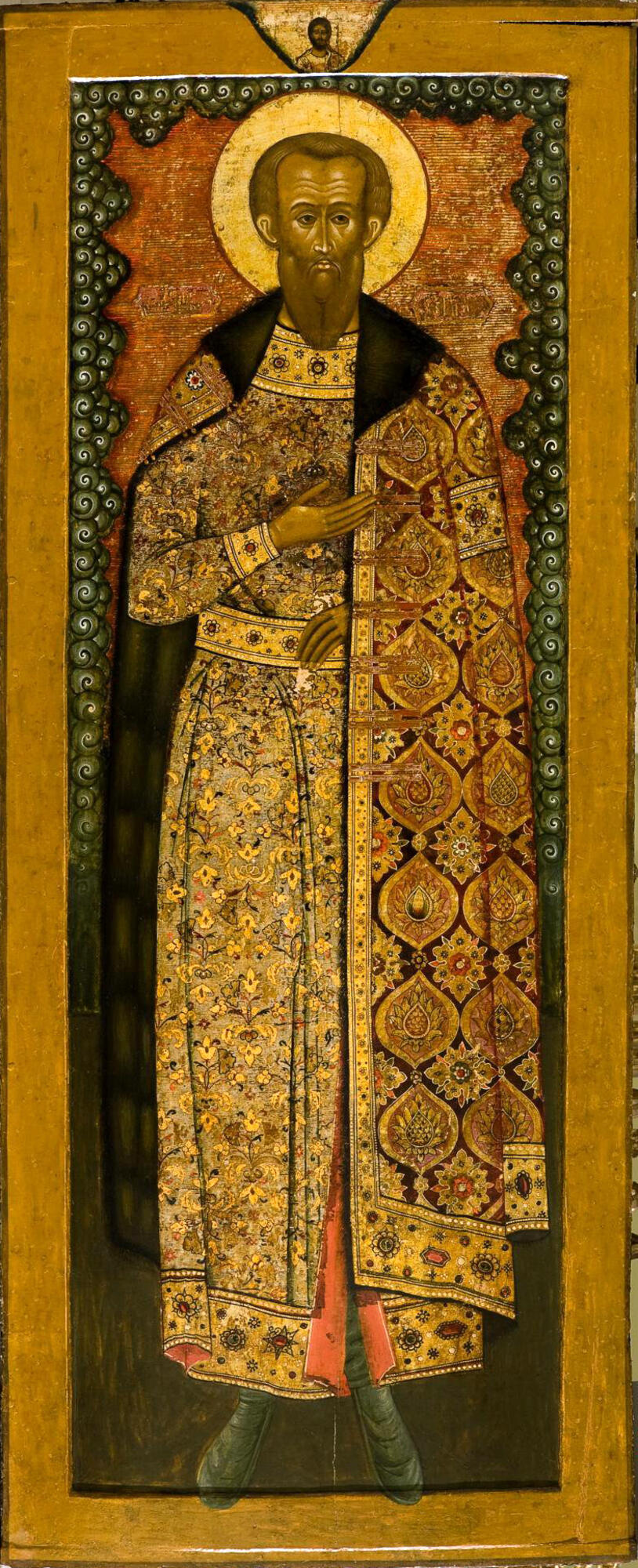The image of Saint Prince Roman from the collection of the Uglich Museum was used as a cover for the reliquary with the saint’s remains. The iconography is associated with the Byzantine tradition of venerating holy relics, according to which, burial grounds were decorated with the “portrait” images of saints. In Russian iconography, the deceased were usually depicted on the coffin board in full length and full face, “as if they were alive”, to celebrate their miraculous incorruptibility.
Saint Prince Roman of Uglich was the son of Vladimir, the first Prince of Uglich. Prince Roman was born on October 1, 1235. The “Uglich Chronicle” refers to Prince Roman as “a peaceful and just person” because he chose not to participate in feuds, “governed his principality wisely and took care of its happiness as its father” and attended only to his own principality’s affairs during the difficult period. According to the number of towns in the Uglich Principality during the reign of Prince Roman, it was referred to as “the seven-town principality” in the chronicle. The hagiography of Saint Prince Roman contains information about his death, “…he died on February 3, 1285… He was interred in the Transfiguration Cathedral, beside the tombs of his father, mother, and wife.”
The image of Saint Roman belongs to the type of the so-called graveside icons that hold a specific place in Russian iconography. The icon is characterized by exquisite craftsmanship that distinguished the best examples of the Moscow school of icon painting in the first half of the 17th century. The air of detachment of the Uglich Prince is in line with the icon’s intended purpose. The icon was created using the tempera technique with a thin layer of paint. The hands and face were depicted using light, reduced pigments almost without any ocher against an olive underpaint. The saint wears a long tunic with a bright red backing. A fur coat with a turn-down collar and long set-in sleeves is thrown over his shoulders. The prince’s clothes are decorated with a rich floral pattern, imitate the style of expensive imported fabrics, and fit tightly to the prince’s narrow-shouldered and long-legged figure.
The modeling of the face resembles the system for depicting volume used by Nazary Istomin who supervised the creation of the most significant icons in the 1620s, mostly commissioned by the patriarch.
Saint Prince Roman of Uglich was the son of Vladimir, the first Prince of Uglich. Prince Roman was born on October 1, 1235. The “Uglich Chronicle” refers to Prince Roman as “a peaceful and just person” because he chose not to participate in feuds, “governed his principality wisely and took care of its happiness as its father” and attended only to his own principality’s affairs during the difficult period. According to the number of towns in the Uglich Principality during the reign of Prince Roman, it was referred to as “the seven-town principality” in the chronicle. The hagiography of Saint Prince Roman contains information about his death, “…he died on February 3, 1285… He was interred in the Transfiguration Cathedral, beside the tombs of his father, mother, and wife.”
The image of Saint Roman belongs to the type of the so-called graveside icons that hold a specific place in Russian iconography. The icon is characterized by exquisite craftsmanship that distinguished the best examples of the Moscow school of icon painting in the first half of the 17th century. The air of detachment of the Uglich Prince is in line with the icon’s intended purpose. The icon was created using the tempera technique with a thin layer of paint. The hands and face were depicted using light, reduced pigments almost without any ocher against an olive underpaint. The saint wears a long tunic with a bright red backing. A fur coat with a turn-down collar and long set-in sleeves is thrown over his shoulders. The prince’s clothes are decorated with a rich floral pattern, imitate the style of expensive imported fabrics, and fit tightly to the prince’s narrow-shouldered and long-legged figure.
The modeling of the face resembles the system for depicting volume used by Nazary Istomin who supervised the creation of the most significant icons in the 1620s, mostly commissioned by the patriarch.


